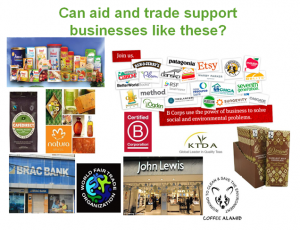Can business structure influence social impact?
Business is essential to tackling poverty, and the development world has come to embrace this. It is now widely acknowledged that we need to see more businesses investing, trading and employing inclusively if we are to tackle poverty.
While definitions of inclusive business vary (e.g. this one from the FAO is among the more ambitious), most agree that it needs to encompass respecting rights and generating economic opportunities. So how do we get more inclusive business practices? Among other things, we need to look inside businesses, at their DNA, to ensure they are wired to make commercial decisions that lead to inclusive and sustainable development. For donors, this means better understanding the kinds of companies they are partnering with, and the kind of businesses they are promoting.
Businesses are diverse in the way they are owned and governed. In particular, this diversity may matter when there are trade-offs between the interests of stakeholders (such as workers, farmers, communities and investors).
Use of profits
Take for instance, what is done with profits at year end. Some businesses prioritise investing it in business expansion, some rewarding workers (investing into productivity or workforce stability) and others maximising dividends to shareholders. For the mainstream western corporate model, the trend has been to prioritise the latter. In the 1970s, UK companies paid about 10 per cent of their profits in dividends. That has increased to about 70 per cent today, and this trend is mirrored across many other economies. Meanwhile, employee-owned enterprises (e.g. John Lewis Partnership) and farmer-owned enterprises (e.g. Divine Chocolate) use their profits to both reinvest in their business, and pay a bonus or dividend to workers and farmers. Clearly, the ownership and governance structure of businesses can drive how they prioritise competing interests in relation to use of their profits.
Prioritising local development
There are other scenarios where corporate structure can drive development outcomes. An example is a Sri Lankan dairy processing enterprise I recently came across. This enterprise had the choice of continuing to source from local dairy farmers or to buy imported powdered milk – both commercially viable (ie profitable), but the latter more profitable. As an enterprise that embedded a clear mission to support local economic development, it decided to continue sourcing locally. Putting aside which scenario is more impactful for development, the governance structure of that business shaped a decision that clearly had significant implications on its developmental impact.
Sharing more value with workers, farmers and consumers?
Critically, these differences in ownership and governance can lead to significant impacts on the equality of economic growth. For instance, the Kenyan Tea Development Agency is co-owned by 550,000 small-scale tea farmers with 66 tea processing factories; it enables farmers to receive over 75 per cent of the final tea price. Meanwhile, tea farmers in nearby Rwanda operating through more traditional business structures, only earn 25 per cent. How value is shared varies across businesses and supply chains. As development practitioners, we should favour outcomes where low-income workers, farmers and consumers end up capturing more value.
‘So what?’ for development practitioners
The recent report published by Oxfam and the Donor Committee for Enterprise Development explains in greater detail the characteristics of structure that determine the DNA of a business. Key elements are categorised as: (a) statutory form, (b) internal corporate governance, and (c) ownership model. This provides a lens through which development practitioners can evaluate businesses, which is important for two reasons.
- Business partnerships: it is critical to understand the objectives and stakeholder interests its structure allows it to prioritise.
- Economic and business growth: development practitioners may have an opportunity to shape the kinds of business structures that take-root and expand in developing countries (e.g. through value chains and governance projects). For instance, it was DFID's loan guarantee to Divine Chocolate, that allowed this partly farmer-owned and farmer-governed chocolate brand to become established and achieve commercial success. The development world can be a catalyst for such models. Being more deliberate about this can determine the developmental impacts that businesses have over the longer-term.
This isn’t a call to exclusively work with and promote cooperatives and soc

ial businesses. The spectrum of business structures is more diverse and the impacts of business is more complex than that. Clearly, traditionally structured companies can also be a force to galvanise for development. However it is important to know the strengths and limitations underpinning any specific company or business structure. And there is a need for holistic research into how corporate structures, alongside other factors such as leadership, culture, regulatory frameworks and consumer engagement, may influence the pursuit of sustainability objectives, in order to inform the design of effective donor strategies. The development world seems to be at the early stages of a journey to better understand these questions.
This blog is part of the January 2017 series on how, and why, donors and businesses work together for development impact. For more candid opinions on what works, and what doesn't, read the full series on demystifying donor-business collaborations.